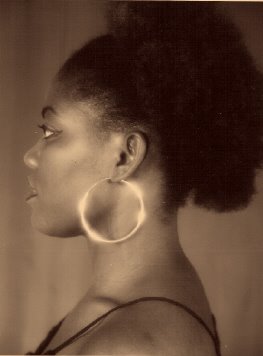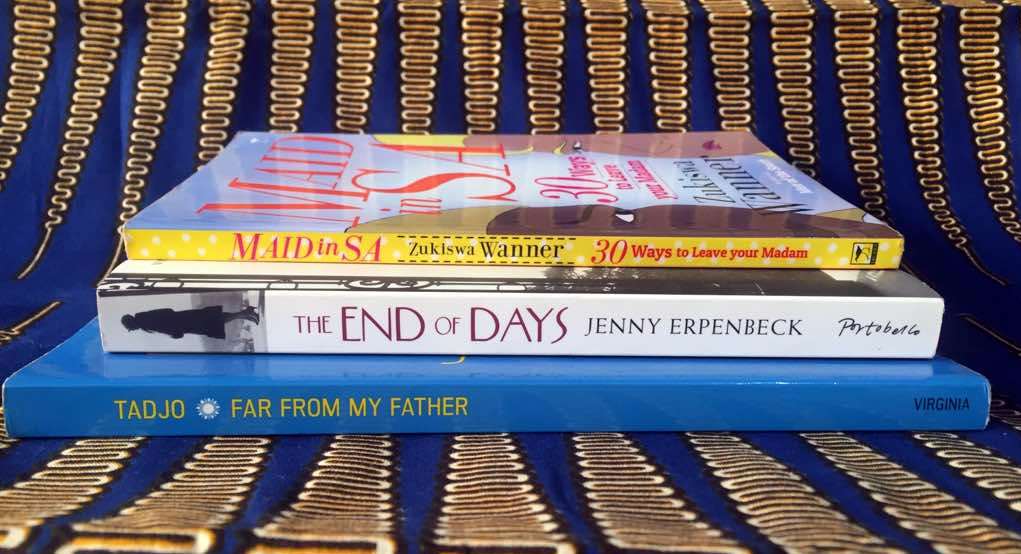
Launching Adichie’s Half of a Yellow Sun
By Molara Wood
Thursday, 17th of August, and I came out of Piccadilly Circus station in London’s West End, and headed for Waterstone’s bookshop. It was the venue for a discussion between two writers riding the crest of the wave of new Nigerian writing. Chimamanda Ngozi Adichie, author of Purple Hibiscus, was to discuss her new novel, Half of a Yellow Sun, with Segun Afolabi, winner of the 2005 Caine Prize and author of A Life Elsewhere.
I entered into Waterstone’s and right from the ground floor, I passed disappointed book lovers heading out the door. One Nigerian lady took the trouble to explain to me that there was no more room in the audience, and that new arrivals were being turned away. Still, I took the lift up.
Fifth floor, and the lift could go no higher, but there was yet another flight of stairs to the sixth floor. There at last, I found I could only spy Afolabi and Adichie through the door’s glass panels. It was big enough a room, but it should have been bigger, had Waterstone’s accurately judged the level of interest. Two people were stationed at the door, their backs to it, so one could push in. People milled around outside, disappointment written on their faces. It is probably no exaggeration to say that those turned away, outnumbered those inside. I was one of the disappointed ones.
And I didn’t give up easily. “I’m not here just to look at their mouths,” I told the Waterstone’s representative. “I am going to write about this, so it’s important I get in because readers in Nigeria should be informed of this event.” It didn’t work. It was pointed out to me, ever so politely, that I arrived fifteen minutes later than the starting time anyway. “Yes, train delays,” I offered. Besides, the room was already so packed that if they let another person in, they would be in breach of health and safety regulations, I was told. Adichie’s publicist, Michelle, was inside, unaware of my sticky situation.
 The bookshop’s representative admitted that they had not expected so many people to turn up for the event. Did I want to fill out a form to lodge a complaint? She asked. I declined, but told her: “Clearly, you underestimated the pulling power of the writers in that room.” With that, it was back down six floors for me, onto the ground floor and out into the street. It was just as well I attended the launch of Half of a Yellow Sun the evening before, I consoled myself.
The bookshop’s representative admitted that they had not expected so many people to turn up for the event. Did I want to fill out a form to lodge a complaint? She asked. I declined, but told her: “Clearly, you underestimated the pulling power of the writers in that room.” With that, it was back down six floors for me, onto the ground floor and out into the street. It was just as well I attended the launch of Half of a Yellow Sun the evening before, I consoled myself.Chimamanda Ngozi Adichie’s second novel has been described in UK literary circles as “eagerly awaited.” They shall wait no more, with the launch of the book on Wednesday 16th August at the Institute of Commonwealth Studies in London. Hosting the event, was the Royal African Society, whose director, Richard Dowden, introduced the book on the night. Dowden read Purple Hibiscus and loved it so much that he told Adichie: “We will do your second book.” So this was the ‘do’.
In the room, a table was laid out with colourful, hardback copies of Half of a Yellow Sun - all 433 pages of it. Among artworks on the walls, a frame with an image identical to the boy’s face on the UK edition, stood out. Closer inspection revealed that it was in a fact a wood panel, already chipped at the edges, probably salvaged from a barber-shop in West Africa somewhere. It hinted at the source of inspiration for the cover design.
“Chimamanda will arrive fashionably late,” someone joked, while the guests filled their glasses and mingled, as civilised book people do. The novelist, fresh from appearances at the Edinburgh Book Festival where she met Ngugi wa Thiong’o for the first time - arrived soon after the 7pm start.
Giving his impression of the book at the launch, was Dr Kwandwo Osei-Nyame Jnr, lecturer of African Literature and Cultural Studies at SOAS (School of African and Oriental Studies, London). “What I find so interesting is that [the book] talks so much about the ordinary, bringing in the concept of the Nigerian nation state, with Biafra, and the attempt to create that.” He praised “the depth of characterisation - all these people who invent and reinvent themselves - you feel as if you are living the lives in the book.” The academic had not read Purple Hibiscus, “but after this brilliant book, I will read it.”
Osei-Nyame later shared more thoughts on Adichie’s book. “It takes us back to those years of Biafra - the historical memory - not in some crude, ideological way, but in a very simple and simultaneously complex narrative. Half of a Yellow Sun is a very important piece of work and the manner in which [Adichie] presents the writing, connects with a lot of conflict going on today. You can go outside Nigeria and put it in international context.”
Adichie’s editor, Mitzi Angel, also called Half of a Yellow Sun “a story about war in general, because she tells this story to ordinary lives. It could find a very big readership; it appeals to all sorts of people.” Angel informed, that Fourth Estate had discovered Purple Hibiscus “by accident.” The publisher’s US scout had sent a newsletter in which Adichie’s debut novel was mentioned in passing. They took notice and contacted the book’s American publisher. According to Angel, “We felt that there was a voice that needed to be noticed.” Similarly, Purple Hibiscus was entered into the Orange Prize because “we thought it was worthy of winning.”
Angel admitted that, when it comes to highly successful first books, there is always the fear that the second one might not be as good. With Adichie, such fears have evaporated, according to Angel, who reported that writers have told her (perhaps echoing what Achebe recently said of the young novelist said to be following in his footsteps): “This is a writer who has arrived fully formed.”
Though she signed autographs and chatted with fans all evening, Adichie spoke only briefly during the official presentations. “I think I’ll just say a few things because I might start to cry,” she said. The author revealed that Half of a Yellow Sun took four years to write, and thanked everyone for coming to share her joy.
- Published in The Guardian, Lagos, Sunday 27th August 2006; images © MW









.jpg)





4 comments:
Read this book. One word - Fantastic! Have a link to her interview on BBC Radio 4 on my blog, which may interest you.
I just read your article on Adichie's latest novel "Half of a Yellow Sun" in The Guardian on Sun day minutes ago.
I read some extracts of the narrative before the novel got published.
I don't want Pa Chinua Achebe to see Chimamanda Ngozi Adichie as his successor. Adichie will surpass Achebe. Achebe's last great novel was "Arrow of God". Achebe has lived on the past glories of "Things Fall Apart" that was published when he was only 28. And instead of Achebe to surpass his previous literary achievements since 1958 to date, he has been publishing works I consider literary apologies and regrets of some sorts. Most people seem to forget that Achebe never peaked. He just got stuck midway. Whereas "Kongi" Professor Wole Soyinka has surpassed his first works and has peaked. Can you compare Achebe's last published work to the last work of Soyinka?
Adichie should be more ambitious than Achebe. As we say in my mother tongue of Igbo, "Nkiruka", the future is greater.
God bless.
I'm so happy for Chimamanda! Thanks MW for this piece. We all look forward to reading this work. I couldn't get myself to the UK for the launch and reading... I reckon I missed a lot!
E
Thanks for this post. I will be putting this book on my must read list
Post a Comment